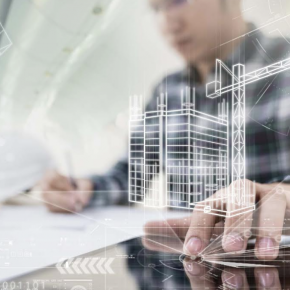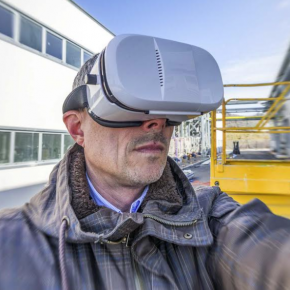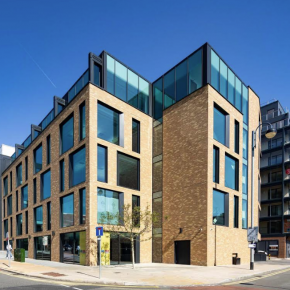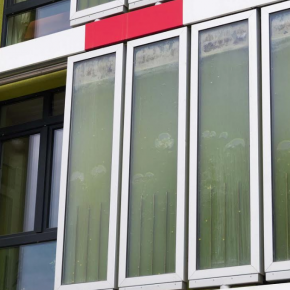
Disruptors in Facade Technology: a piece from Aluprof
 High performance thermal breaks mean it is possible to specify aluminium systems that will help projects reach the Passivhaus standard; here, Wojciech Brożyna – Aluprof UK MD, discusses the emerging technologies that will influence sustainability and efficiency.
High performance thermal breaks mean it is possible to specify aluminium systems that will help projects reach the Passivhaus standard; here, Wojciech Brożyna – Aluprof UK MD, discusses the emerging technologies that will influence sustainability and efficiency.
“35 YEARS ago, CAD revolutionised the way we designed aluminium facades. Here was a system that could easily calculate complex structures, angles and profile lengths making cutting, machining and assembly more cost effective. Later, adding CAD output to CNC machines further influenced efficient manufacture to such an extent that most fabricators now have at least one of these machine centres and design in 3D. BIM is now also filtering down into the fabrication arena which will add further efficiencies in the specification and manufacture of building envelopes.
Cutting edge computer technology in construction is looking to AR, or Augmented Reality, mixing both the physical with the digital. Using either front facing cameras on tablets or AR headsets we will be able to see a digital overlay of a structure either on a structure or a structure yet to complete. This has huge benefits when considering the complexity of setting out and measurement. So not only can the BIM model be used to filter down the product into production, but the AR used on site with the BIM overlay, setting out for the product or facade element, will be achieved more easily and with greater accuracy.
Also finding its way into commercial facades is the composite profile for carrying glazed elements both in terms of windows and curtain wall facades. Having similar expansion co-efficients to glass itself, a fibreglass composite has some good insulation properties and can complement a facade which has a structural grid of aluminium.
Also known as ‘pultrusion’ the process is relatively new and has of late developed a great deal. The process involves a liquid polymer resin and glass fibre mix being pulled through a heated die which cures the polymer whilst aligning the glass fibre strands for optimum strength. This is a process that Aluprof developing for some systems to further enhance our products performance.
Active or smart facades are increasingly being designed to optimise our buildings sustainability. At one time we just looked to the facade to keep out the wether and let the light in. More recently insulation has become an important feature in order to reduce heating costs. New facades are beginning to become active, that is, changing with the time of day and weather conditions.
These active facades include such things as automatic solar shading to reduce solar gain, screens which automatically close at night to maximise insulation and automatic natural ventilation systems to purge stale air. Further enhancements will include smart technologies which will harness solar gain, energy from light and wind to become an energy generator for either immediate use or for storage for future use.
Possibly one of the most unusual developments is the adoption of the bio-facade. Using micro-algae trapped within glazed units offers both solar shading and helps improve interior air quality as the algae grows on the carbon dioxide within the air in the building whilst expelling oxygen in the growth process. Together with this photosynthesis, the process generates heat which can also be harnessed for the buildings use.
The systems, known as photobioreactors (PBR’s), has been used successfully in the BIQ House, a five story apartment building designed by Splitterwerk Architects in collaboration with Arup, where an algae facade is used as a shading device. In its infancy, this technology is being considered for much larger high rise developments.
The vision for the future is to install and maintain facades which become a living ‘skin’ which not only protects the occupants and offers a comfortable stable environment, but offers a further benefit of energy generation. In future years the technologies outlined here will combine to offer essentially a ‘living’ facade which will be truly sustainable.
Here at Aluprof, we are researching all emerging technologies and are happy to work with specifiers wishing to harness these innovative ideas.
As most specifiers know, aluminium is non-flammable, but when it is used in combination with other materials which are, the composite construction can cause potential serious issues. Aluprof are well experienced in fire resistance, having a range products that can offer high levels of fire and smoke control in buildings. Ensuring fire safety is a top priority for Aluprof and its technical support team.
Latest news

28th March 2025
Ideal Heating Commercial announces 10-year warranty on Evomax 2 boiler
Evomax 2, the UK’s number one selling commercial wall-mounted boiler from Ideal Heating Commercial, is now available with a 10-year warranty.
Posted in Articles, Building Industry News, Building Products & Structures, Building Regulations & Accreditations, Building Services, Facility Management & Building Services, Heating Systems, Controls and Management, Heating, Ventilation and Air Conditioning - HVAC, Innovations & New Products, Pipes, Pipes & Fittings, Plumbing, Retrofit & Renovation, Sustainability & Energy Efficiency, Videos
28th March 2025
FLIR Si1-LD Acoustic Imaging Camera for Compressed Air Leak Detection
FLIR, a Teledyne Technologies company, introduces the Si1-LD, an industrial acoustic imaging camera that brings faster and more accurate compressed air leak detection to those operating on a modest condition monitoring budget.
Posted in Acoustics, Noise & Vibration Control, Articles, Building Industry News, Building Products & Structures, Building Services, Facility Management & Building Services, Information Technology, Innovations & New Products, Retrofit & Renovation, Sustainability & Energy Efficiency, Thermal Imaging and Monitors
28th March 2025
LIFTEX 2025 Seminar programme announced
Registration has opened for LIFTEX 2025. Now in its 37th year, LIFTEX 2025 is the UK’s only dedicated exhibition for the lift, escalator and access industry and takes place only once every three years.
Posted in Access Control & Door Entry Systems, Accessibility, Articles, Building Industry Events, Building Industry News, Building Products & Structures, Building Regulations & Accreditations, Building Services, Exhibitions and Conferences, Facility Management & Building Services, Health & Safety, Retrofit & Renovation, Security and Fire Protection, Seminars
28th March 2025
MCRMA welcomes ArcelorMittal UK to membership
A UK division of the global steelmaking business ArcelorMittal has become the latest new member of the MCRMA, the industry association representing the metal building envelope sector.
Posted in Articles, Building Associations & Institutes, Building Industry News, Building Products & Structures, Building Systems, Cladding, Facades, Posts, Restoration & Refurbishment, Retrofit & Renovation, Roofs, Steel and Structural Frames, Walls
 Sign up:
Sign up: 

